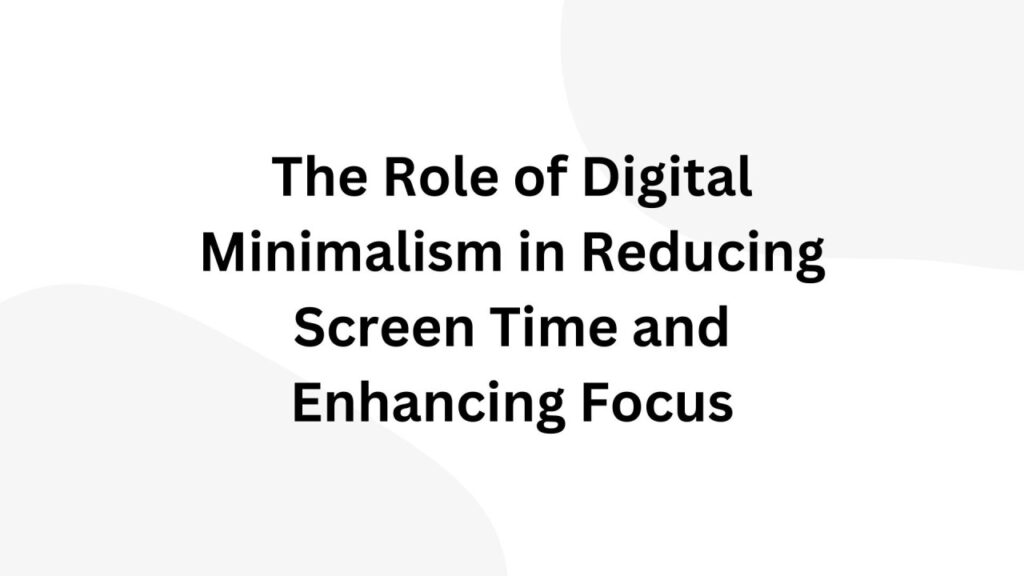In an increasingly digital world where screens dominate our daily lives, the concept of digital minimalism has emerged as a powerful antidote to the constant barrage of information and distractions. Coined by Cal Newport in his book of the same name, digital minimalism advocates for a mindful approach to technology use, aiming to reduce screen time and reclaim our focus and attention.
Understanding Digital Minimalism
At its core, digital minimalism encourages individuals to be intentional about their use of digital tools and platforms. It’s not about rejecting technology altogether but rather about adopting it in a way that serves our well-being and enhances our productivity. This philosophy emphasizes quality over quantity when it comes to digital interactions, urging us to prioritize activities that add value and align with our goals.
The Impact of Excessive Screen Time
The average person spends several hours each day on screens, whether it’s for work, entertainment, or socializing. Excessive screen time has been linked to various negative effects on mental and physical health, including:
- Reduced Productivity: Constant multitasking and the lure of notifications can fragment our attention span, making it harder to focus deeply on tasks.
- Increased Stress and Anxiety: The constant stream of information and social comparisons can contribute to heightened stress levels and feelings of inadequacy.
- Sleep Disruption: Exposure to blue light from screens can disrupt our sleep patterns, leading to insomnia and poor sleep quality.
- Physical Health Issues: Sedentary behavior associated with prolonged screen time can lead to obesity, musculoskeletal problems, and eye strain.
Principles of Digital Minimalism
Digital minimalism offers practical strategies to mitigate these effects and regain control over our digital habits:
- Evaluate and Declutter: Similar to decluttering physical spaces, digital minimalism encourages us to assess our digital tools and apps. Remove those that no longer serve a meaningful purpose or add value to your life.
- Set Boundaries: Establish clear boundaries around when and how you use technology. This could involve setting designated times for checking email or social media, or implementing digital detox periods where screens are completely avoided.
- Focus on Quality Interactions: Rather than passively consuming content, prioritize meaningful interactions. Engage in activities that foster genuine connections and intellectual stimulation.
- Embrace Analog Activities: Incorporate analog activities such as reading physical books, journaling, or engaging in outdoor pursuits that promote mindfulness and reduce screen dependency.
Real-World Examples of Digital Minimalism in Action
Numerous individuals and organizations have embraced digital minimalism with compelling results:
- Tech Leaders’ Practices: Executives like Jack Dorsey (co-founder of Twitter) and Steve Jobs were known for their minimalistic approach to technology use, focusing on simplicity and efficiency.
- Corporate Initiatives: Companies are implementing policies to encourage digital wellness among employees. For example, Google introduced features in Android to monitor screen time and set usage limits.
- Educational Settings: Schools are integrating digital minimalism principles into their curricula to teach students about responsible technology use and the importance of unplugging.
Benefits of Digital Minimalism
By adopting digital minimalism practices, individuals can experience a range of benefits:
- Enhanced Productivity: Reduced distractions lead to improved focus and efficiency in both personal and professional tasks.
- Improved Mental Health: Lower stress levels and increased mindfulness contribute to better overall well-being.
- Enhanced Creativity: Unplugging from digital noise allows for deeper reflection and creativity to flourish.
- Better Relationships: Quality time spent away from screens fosters stronger interpersonal connections and more meaningful interactions.
Conclusion
In conclusion, digital minimalism offers a compelling framework for navigating our digital age with intentionality and mindfulness. By reducing screen time and prioritizing meaningful interactions, individuals can reclaim their focus, improve their mental well-being, and lead more fulfilling lives. Embracing digital minimalism isn’t just a trend; it’s a proactive step towards a healthier relationship with technology in an increasingly connected world.
As we continue to navigate the complexities of modern life, integrating principles of digital minimalism can empower us to harness the benefits of technology while safeguarding our mental and physical health. By striking a balance between digital engagement and intentional disconnection, we can cultivate a more sustainable approach to living in the digital age.







